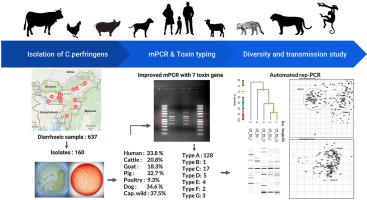Anaerobe ( IF 2.3 ) Pub Date : 2021-06-02 , DOI: 10.1016/j.anaerobe.2021.102383 Md Iftikar Hussain 1 , Probodh Borah 2 , Isfaqul Hussain 3 , Rajeev Kumar Sharma 4 , Mohan Chandra Kalita 5

|
An epidemiological study was conducted in North-East India (part of Indo-Burma biodiversity hotspot) to better understand the distribution, diversity, and transmission of Clostridium perfringens among livestock, pets, wild animals (captive), and humans. A total of 160 C. perfringens isolates were recovered from 642 diarrhoeic faecal samples with an isolation rate of 24.92%. Isolation rate was the highest among captive wild animals (37.5%) followed by dog (34.6%), human (33.8%), pig (32.7%), cattle (20.8%), goat (18.3%) and poultry (9.3%). Isolates were toxin typed using a seven gene multiplex PCR designed for simultaneous detection of cpa, cpb, cpb2, etx, iap, cpe and netB. The majority of isolates, 128 (80%) were of type A, followed by 17 (10.62%), 5 (3.12%), 4 (2.5%), 3 (1.87%), 2 (1.25%) and 1 (0.63%) isolates of type C, D, E, G, F and B, respectively. Beta 2 toxin gene was present in 65 (50%) of type A isolates, followed by 7 (41.2%), 4 (80%), 1(25%), and 1 (100%) of type C, D, G and B isolates, respectively. Beta 2 toxin has a high prevalence among dogs (28.6%), cattle (27.3%), and pig (20.8%) compared to humans, goat, wild animals, and poultry (1.2–14.3%). The prevalence of CPE and NetB toxin-positive strains was low, with only 3 (1.8%) and 5 (3.1%) isolates, respectively. Association of C. perfringens with diarrhoea in Civet Cat, Golden Langur, and Gray Langur has been reported for the first time. The genetic diversity and transmission of isolates were investigated using automated rep-PCR (Diversilab®, bioMérieux) using two densitometry-based matrices: modified Kullback–Leibler (KL) and Pearson's correlation (PC). The PC and modified KL matrices formed three distinct clusters with 59% and 27.2% similarity, respectively. C. perfringens diversity and transmission were best studied using modified KL matrix that placed more emphasis on the presence of bands rather than intensity. However, the PC method was found to be more suitable for differentiating strains within a toxin type, with slightly higher D-values.



























 京公网安备 11010802027423号
京公网安备 11010802027423号